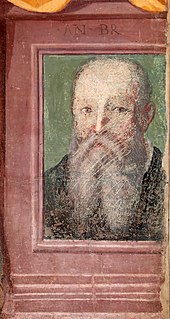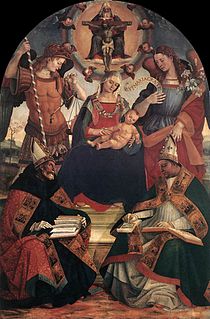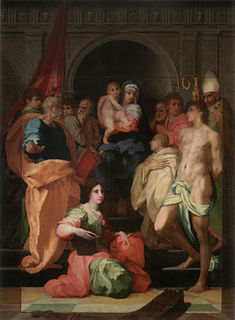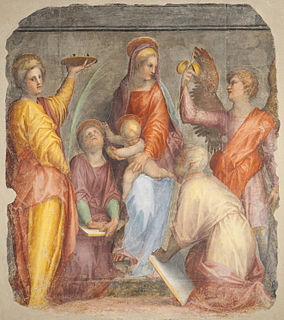
Franciabigio was an Italian painter of the Florentine Renaissance. His true name may have been Francesco di Cristofano; he also is referred to as either Marcantonio Franciabigio or Francia Bigio.

Agnolo di Cosimo, usually known as Bronzino or Agnolo Bronzino, was an Italian Mannerist painter from Florence. His sobriquet, Bronzino, may refer to his relatively dark skin or reddish hair.

Francesco d'Ubertino Verdi, called Bachiacca. He is also known as Francesco Ubertini, il Bacchiacca (1494–1557). He was an Italian painter of the Renaissance whose work is characteristic of the Florentine Mannerist style.

Pier Francesco Foschi (1502–1567) was an Italian painter active in Florence in a Mannerist style. He was pupil of Andrea del Sarto and assisted Pontormo with his frescoes at Careggi in 1536. He completed 3 altarpieces, commissioned in 1540–1545 for the church of Santo Spirito in Florence: an Immaculate Conception, Resurrection, and a Transfiguration. Foschi was also influenced by Il Bronzino. One of his pupils was Alessandro Fei.

Andrea del Sarto was an Italian painter from Florence, whose career flourished during the High Renaissance and early Mannerism. He was known as an outstanding fresco decorator, painter of altar-pieces, portraitist, draughtsman, and colorist. Though highly regarded during his lifetime as an artist senza errori, his renown was eclipsed after his death by that of his contemporaries Leonardo da Vinci, Michelangelo, and Raphael.

Virgin with the Standing Child, Embracing his Mother, also known as Willys Madonna is a painting by the Italian Renaissance master Giovanni Bellini. It is now in the São Paulo Museum of Art in São Paulo, Brazil.

The Madonna of the Rose Garden is a tempera on panel painting made by Sandro Botticelli, whose date of between 1469 and 1470 makes it one of his earliest paintings. It is now in the Uffizi Gallery in Florence.

Irene Parenti Duclos (1754–1795) was an Italian painter and poet. Her work as an expert copyist of old master paintings was highly valued in her era, and brought her honors from several Italian art academies. Moreover, she achieved particular renown as a pioneer in the revival of encaustic painting.

The Madonna of the Caves is a tempera on panel painting measuring 32 cm 29.6 cm. It was painted in 1488-1490 by the Italian painter Andrea Mantegna and is now in the Uffizi Gallery in Florence.

Portrait of a Boy is a 1495 oil on panel portrait, now in the Uffizi in Florence. In the past it has been attributed to Lorenzo di Credi, Viti, Jacopo Francia, Raphael and others, but Giovanni Morelli's reattribution of it to Perugino is now widely accepted. Although the lack of a landscape background is unusual for this painter, the style is typical of his portrait technique.

Madonna and Child with the Holy Trinity and Two Saints is a painting by Luca Signorelli, from 1510, now in the Uffizi in Florence. It is a sacra conversazione, with the Madonna enthroned between Michael and Gabriel, with Augustine (left) and Athanasius (right) below and the Holy Trinity above.

Portrait of a Young Man is an oil on panel painting by Parmigianino, executed c. 1530, now in the Uffizi in Florence, whose collection it entered on 27 October 1682. Three copies survive in the Museo di Capodimonte, Rome's Accademia di San Luca and the Galleria nazionale di Parma.

The Dei Altarpiece is an oil on panel painting by Rosso Fiorentino, commissioned in 1509 by the Dei family and completed in 1522. It is now in Florence's Galleria Palatina, whilst the Uffizi holds a preparatory drawing which may be the original idea for the work.

Woman with a Basket of Spindles is an oil on panel painting, executed c. 1514–1515, now in the Uffizi in Florence. It is attributed to Pontormo or Andrea del Sarto. The work arrived in the Palazzo Pitti's gallery in 1773, as recorded in a note on the reverse, and in 1784 it was hanging in the Sala dell'Ermafrodito. It was last restored in 1996.

Madonna and Child with the Infant Saint John the Baptist is an oil on panel painting by Pontormo, now in the Uffizi, whose Gabinetto dei Disegni e delle Stampe also houses a preparatory drawing for the work. The two theories on its dating are 1534-1536 and Antonio Natali's theory of 1529–1530.

The Boldrone Shrine is located at the corner of the Via di Boldrone and the Via dell'Osservatorio in the Quarto district of Florence. It was named after the monastery of San Giovanni Evangelista di Boldrone, which was itself named after the French "Boldrone" hermitage founded on that site in the 13th century.

The San Ruffillo Madonna is a fresco fragment by Pontormo, executed c. 1514, originally in the San Ruffillo church in Florence.

Portrait of Maria Salviati is an oil on panel painting attributed to Pontormo, executed c. 1543–1544, in the Uffizi, Florence.

Portrait of a Musician is an oil painting on panel by Pontormo in the Uffizi. It is dated on stylistic grounds to c. 1518–1519; the art historian Luciano Berti places it in Pontormo's youthful phase alongside his Pucci Altarpiece, Saint John the Evangelist and Michael the Archangel.

Madonna and Child with Saint Zechariah is a c.1530–1533 oil on panel painting by Parmigianino, now in the Uffizi. It shows the Madonna and Child with Zechariah, father of John the Baptist.




















